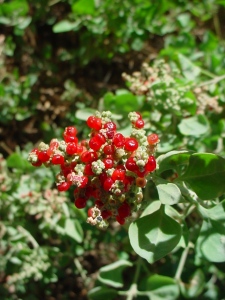
A grey-white powder on the leaves and red berries are the give aways for identifying Rhagodia parabolica
Common names: Mealy Saltbush, Fragrant Saltbush
Taxonomic name: Rhagodia parabolica, Chenopodium parabolicum
Family: Amaranthaceae
Habitat: Sandy areas, Mallee
Form: Spreading bush to 2 metres
Flowering Time: Summer
Kaurna name: Niplina
Description
Mealy or Fragrant Saltbush (Rhagodia parabolica also Chenopodium parabolicum) is a very common plant around the Gawler area and practically everywhere I’ve been in South Australia, as they are a favourite plant of councils and landscapers because of their colour, dense growth and height up to 2 m.
Definitely the best way to identify Mealy saltbush is to examine the leaves. They are thick and grey – green and have a grey – white powder on them (the ‘mealy’ in Mealy Saltbush). They are also curved slightly into almost a bowl shape – that’s where the ‘parabolica’ in the taxonomic name comes from – ‘parabola’. Flowers are tiny and green and on branching panicles of flowers at the end of branches. These become dense clusters of red berries on the flower stems and are a good indicator when in season.
Uses
The berries are edible and I think could be used for a red dye. Young leaves are edible but musty be cooked for a while (some suggest an hour) and discard the water as the leaves contain much of their weight as salt.

